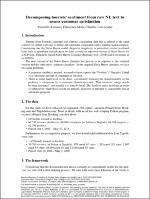Chapter Decomposing tourists’ sentiment from raw NL text to assess customer satisfaction
| dc.contributor.author | Romano, Maurizio | |
| dc.contributor.author | MOLA, FRANCESCO | |
| dc.contributor.author | CONVERSANO, CLAUDIO | |
| dc.date.accessioned | 2022-06-01T12:19:16Z | |
| dc.date.available | 2022-06-01T12:19:16Z | |
| dc.date.issued | 2021 | |
| dc.identifier | ONIX_20220601_9788855183048_509 | |
| dc.identifier.issn | 2704-5846 | |
| dc.identifier.uri | https://library.oapen.org/handle/20.500.12657/56324 | |
| dc.description.abstract | The importance of the Word of Mouth is growing day by day in many topics. This phenomenon is evident in everyday life, e.g., the rise of influencers and social media managers. If more people positively debate specific products, then even more people are encouraged to buy them and vice versa. This effect is directly affected by the relationship between the potential customer and the reviewer. Moreover, considering the negative reporting bias is evident in how the Word of Mouth analysis is of absolute interest in many fields. We propose an algorithm to extract the sentiment from a natural language text corpus. The combined approach of Neural Networks, with high predictive power but more challenging interpretation, with more simple but informative models, allows us to quantify a sentiment with a numeric value and to predict if a sentence has a positive (negative) sentiment. The assessment of an objective quantity improves the interpretation of the results in many fields. For example, it is possible to identify crucial specific sectors that require intervention, improving the company's services whilst finding the strengths of the company himself (useful for advertising campaigns). Moreover, considering that the time information is usually available in textual data with a web origin, to analyze trends on macro/micro topics. After showing how to properly reduce the dimensionality of the textual data with a data-cleaning phase, we show how to combine: WordEmbedding, K-Means clustering, SentiWordNet, and the Threshold-based Naïve Bayes classifier. We apply this method to Booking.com and TripAdvisor.com data, analyzing the sentiment of people who discuss a particular issue, providing an example of customer satisfaction. | |
| dc.language | English | |
| dc.relation.ispartofseries | Proceedings e report | |
| dc.subject.other | GSD | |
| dc.subject.other | WoM | |
| dc.subject.other | Threshold-based Naïve | |
| dc.subject.other | Bayes | |
| dc.subject.other | NLP | |
| dc.subject.other | Sentiment Analysis | |
| dc.subject.other | Customer Satisfaction | |
| dc.title | Chapter Decomposing tourists’ sentiment from raw NL text to assess customer satisfaction | |
| dc.type | chapter | |
| oapen.identifier.doi | 10.36253/978-88-5518-304-8.29 | |
| oapen.relation.isPublishedBy | bf65d21a-78e5-4ba2-983a-dbfa90962870 | |
| oapen.relation.isbn | 9788855183048 | |
| oapen.series.number | 127 | |
| oapen.pages | 5 | |
| oapen.place.publication | Florence |

